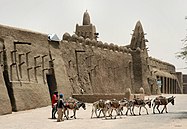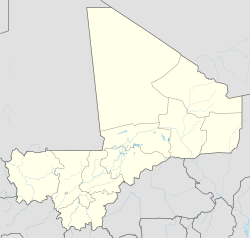Timbuktu
Himba | |
|---|---|
City | |
| Names transcription(s) | |
| • Tamashek | ⵜⵏⵀⵗⵜ تِينْ بُكْتْ |
| • Koyra Chiini | تُمْبُتُ |
Left to right: Djinguereber Mosque, Sankore Madrasah, Aerial view of Timbuktu, The market of Timbuktu, Fennek in Timbuktu airport. | |
 Map showing main trans-Saharan caravan routes c. 1400. Also shown are the Ghana Empire (until the 13th century) and 13th – 15th century Mali Empire, with the western route running from Djenné via Timbuktu to Sijilmassa. Present day Niger in yellow. | |
| Coordinates: 16°46′33″N 3°00′34″W / 16.77583°N 3.00944°W | |
| Country | |
| Region | Tombouctou Region |
| Cercle | Timbuktu Cercle |
| Settled | 5th century BCE |
| Area | |
| • Land | 21 km2 (8 sq mi) |
| Elevation | 261 m (856 ft) |
| Population | |
• Total | 54,453 |
| Climate | BWh |
| Criteria | Cultural: ii, iv, v |
| Reference | 119 |
| Inscription | 1988 (12th Session) |
| Endangered | 1990–2005; 2012–present |
Timbuktu (/ˌtɪmbʌkˈtuː/ TIM-buk-TOO; French: Tombouctou; Koyra Chiini: Tumbutu; Tuareg: ⵜⵏⵀⵗⵜ, romanized: Tin Bukt) is an ancient city in Mali, situated 20 kilometres (12 miles) north of the Niger River. It is the capital of the Tombouctou Region, one of the eight administrative regions of Mali, having a population of 54,453 in the 2009 census.
Archaeological evidence suggests prehistoric settlements in the region, predating the city's Islamic scholarly and trade prominence in the medieval period. Timbuktu began as a seasonal settlement and became permanent early in the 12th century. After a shift in trading routes, particularly after the visit by Mansa Musa around 1325, Timbuktu flourished, due to its strategic location, from the trade in salt, gold, and ivory. It gradually expanded as an important Islamic city on the Saharan trade route and attracted many scholars and traders before it became part of the Mali Empire early in the 14th century. In the first half of the 15th century, the Tuareg people took control for a short period, until the expanding Songhai Empire absorbed it in 1468.
A Moroccan army defeated the Songhai in 1591 and made Timbuktu their capital. The invaders established a new ruling class, the Arma, who after 1612 became virtually independent of Morocco. In its golden age, the town's Islamic scholars and extensive trade network supported an important book trade. Together with the campuses of the Sankore Madrasah, an Islamic university, this established Timbuktu as a scholarly centre in Africa. Notable historic writers, such as Shabeni and Leo Africanus, wrote about the city. These stories fuelled speculation in Europe, where the city's reputation shifted from being rich to mysterious. The city's golden age as a major learning and cultural centre of the Mali Empire was followed by a long period of decline. Different tribes governed until the French took over Mali in 1893, in a regime that lasted until the country became the Republic of Mali in 1960.
In recent history, Timbuktu faced threats from extremist groups leading to the destruction of cultural sites; efforts by local and international communities have aimed to preserve its heritage. The city's population has declined as a result of the recent issues.
- ^ a b "2016 TOMBOUCTOU PRIX INTERNATIONAL CGLU-VILLE DE MEXICO-CULTURE 21 CATÉGORIE VILLE/GOUVERNEMENT LOCAL GAGNANT 2016" (PDF). United Cities and Local Governments. Retrieved 17 July 2024.
- ^ "A Guide to Timbuktu". education.nationalgeographic.org.





